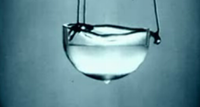
Photo from wikipedia
Lead halide perovskites often suffer from a strong hysteretic behavior on their j-V response in photovoltaic devices that has been correlated with slow ion migration. Electron extraction layer has often… Click to show full abstract
Lead halide perovskites often suffer from a strong hysteretic behavior on their j-V response in photovoltaic devices that has been correlated with slow ion migration. Electron extraction layer has often been pointed as the main responsible for the observed hysteretic behavior. In this work we focus on three hole transport layers with welldefined HOMO levels and interestingly the hysteretic behavior is markedly different. Here we show that an adequate energy level alignment between HOMO level of the extraction layer and valence band of the perovskite not only reduces degradation of the HTL but also totally suppresses the hysteresis avoiding charge accumulation at the interfaces. Numerical simulation suggests that formation of an injection barrier at the organic/perovskite hetero-interface can be one mechanism causing hysteresis. The suppression of such barriers may require novel design rules for interface materials. Overall, this work highlights that both external contacts need to be carefully optimized in order to obtain hysteresis-free perovskite devices.
Journal Title: Advanced Energy Materials
Year Published: 2018
Link to full text (if available)
Share on Social Media: Sign Up to like & get
recommendations!